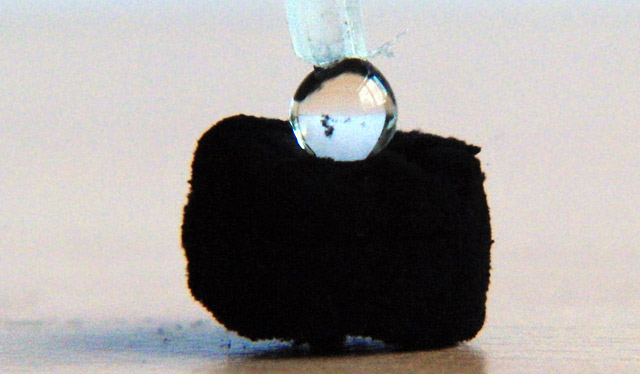A network of porous carbon tubes that is three-dimensionally interwoven at nano and micro level – this is the lightest material in the world.

Aerographite is water-repellent, jet-black and electrically conductive (Kiel University)
Produced by researchers from Kiel University and Hamburg University of Technology, it weights only 0.2 milligrams per cubic centimeter, but it is very strong nevertheless. The new carbon-made material, called ‘Aerographite’, is described in a paper in the journal Advanced Materials.
It is jet-black, electrically conductive, ductile and non-transparent. With these unique properties and very low density the material clearly outperforms all similar materials.
“Our work is causing great discussions in the scientific community. Aerographite weights four times less than world-record-holder up to now,” said co-author Matthias Mecklenburg, a PhD student at the Hamburg University of Technology.
“The hitherto lightest material of the world, a nickel material that was presented to the public about six months ago, is also constructed of tiny tubes. Only, nickel has a higher atomic mass than carbon. Also, we are able to produce tubes with porous walls. That makes them extremely light,” said co-author Arnim Schuchard, a PhD student at Kiel University.
Despite of its low weight, Aerographite is highly resilient. While lightweight materials normally withstand compression but not tension, Aerographite features both: an excellent compression and tension load. “It is able to be compressed up to 95 percent and be pulled back to its original form without any damage,” said Prof Rainer Adelung of Kiel University. “Up to a certain point the Aerographite will become even more solid and therefore stronger than before.”
“Other materials become weaker and less stable when exposed to such stress. Also, the newly constructed material absorbs light rays almost completely. One could say it creates the blackest black”, said Hamburg’s Prof Karl Schulte.
“Think of the Aerographite as an ivy-web, which winds itself around a tree. And than take away the tree”, Prof Adelung said.
According to the scientists, further areas of application could be the electrical conductivity of synthetic materials. Non-conductive plastic could be transformed, without causing it to gain weight. Static, which occur to most people daily, could hence be avoided.
Due to its unique material characteristics, Aerographite could fit onto the electrodes of Li-ion batteries. In that case, only a minimal amount of battery electrolyte would be necessary, which then would lead to an important reduction in the battery’s weight.
_______
Bibliographic information: Mecklenburg M et al. 2012. Aerographite: Ultra Lightweight, Flexible Nanowall, Carbon Microtube Material with Outstanding Mechanical Performance. Advanced Materials vol 24, issue 26, pp. 3486–3490, July 10, 2012; doi: 10.1002/adma.201200491







